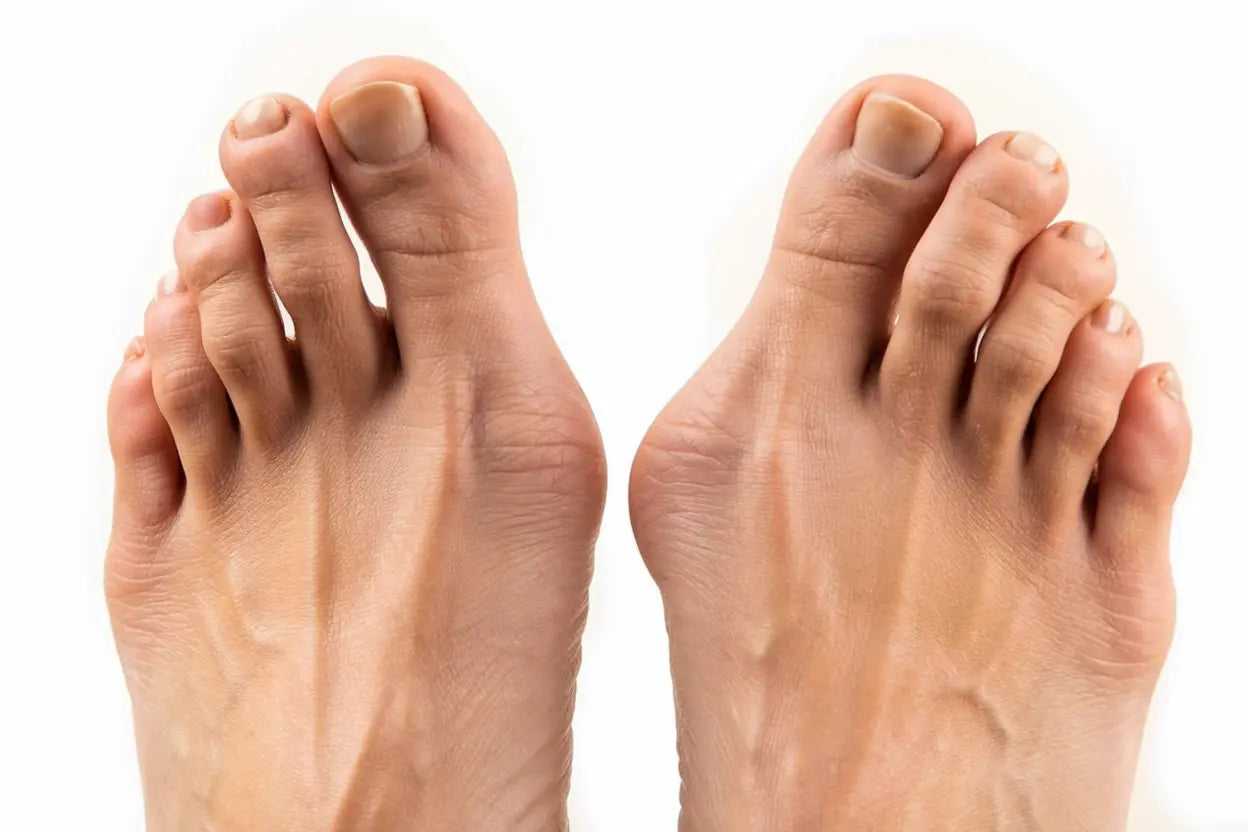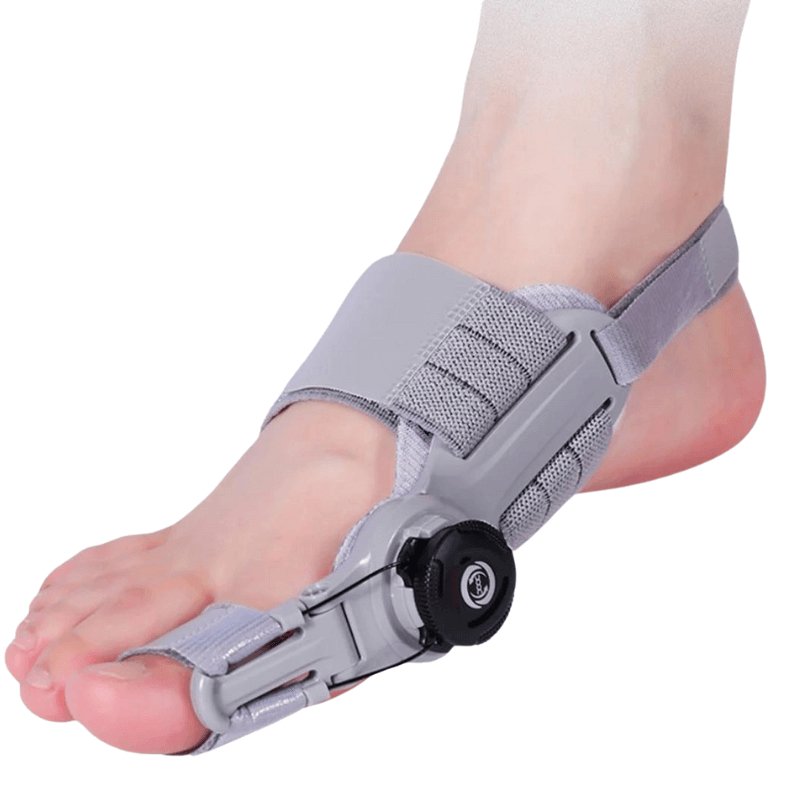Hallux Valgus: Symptoms, Causes, and Treatment

Hallux valgus, also known as bunion, is a common foot deformity that often leads to significant pain and discomfort. If you are searching for "hallux valgus pain", you have come to the right place – this article provides an in-depth overview of the condition, focusing on the pain, its causes and the best treatment options. We combine medical knowledge with practical advice to help relieve the discomfort. Whether you are experiencing mild symptoms or looking for ways to manage chronic hallux valgus pain, you will find valuable information here. We also recommend ToeComfort™ as an effective, non-invasive support for daily relief.
What is Hallux Valgus?
Hallux valgus is a progressive deformity in which the big toe (hallux) angles outward (valgus) toward the other toes. This creates a bulge, or bump, on the inside of the foot at the base of the big toe, often called a bunion. The bump can become inflamed due to friction against shoes, leading to hallux valgus inflammation with swelling and redness. Over time, the deformity can affect the entire forefoot, including other toes, and cause secondary problems such as hammertoes or overlapping toes. The condition is more common in women and may begin to manifest in middle age or earlier in teenagers.
Hallux valgus pain often occurs when the bunion is pressed against shoes or under load, and if left untreated, it can lead to altered gait and additional pain in the foot, ankle or knee.
Typical Symptoms of Hallux Valgus
The symptoms of hallux valgus vary, but pain is the most prominent complaint for many. Here are the most common signs:
- Hallux valgus pain in the big toe joint: Pain that worsens when walking, standing, or wearing tight shoes. The pain may be sharp or dull and radiate down the foot or into the toe.
- Visible lump and swelling: A bulge on the inside of the foot that becomes red, inflamed, and tender to the touch.
- Redness and irritation: Friction against shoes leads to hallux valgus inflammation, which increases hallux valgus pain and can make the hallux valgus area sore.
- Limited mobility: The big toe becomes stiff, making it difficult to bend or stretch it without discomfort.
- Difficulty with shoes: Tight shoes worsen symptoms, and it becomes challenging to find comfortable alternatives.
- Complications: Can lead to hammertoes on other toes, calluses, ulcers or pain under the ball of the foot. In some cases, the little toe is also affected (hallux valgus), and if untreated, it can cause pain in the hallux valgus under the foot or in the heel, similar to a heel spur.
Causes of Hallux Valgus
Hallux valgus is caused by a combination of factors, and while the deformity itself is not always painful, these contribute to progression and pain:
- Genetic predisposition : Heredity plays a big role; if family members have the condition, the risk increases.
- Shoes and lifestyle : Tight, high-heeled or narrow shoes push the big toe inward, which worsens the deformity. Women are more often affected because of this.
- Foot structure : A flat arch or weak muscles in the foot and lower leg can contribute to instability.
- Inflammatory diseases : Arthritis, rheumatism or other joint diseases can accelerate the progression.
- Injury or age : Previous foot trauma or natural changes in foot structure from middle age onwards.
The arch of the foot can flatten, widening the forefoot and increasing pressure on the toes. Hallux rigidus, a stiff variant, shares similar causes.
Diagnosis of Hallux Valgus
To diagnose hallux valgus and assess the pain, a doctor or podiatrist will begin with a physical examination of the shape of the foot, the angle of the big toe, and the gait pattern. X-rays are often used to measure the degree of deformity and rule out other problems such as arthritis. In complicated cases, MRI or gait analysis may be necessary. X-rays show increased distance between the metatarsal bones and a widened big toe joint.
Early diagnosis is important to reduce hallux valgus pain and prevent progression – contact a healthcare center if symptoms affect your everyday life.
Treatment for Hallux Valgus Pain
Effective hallux valgus treatment focuses on relieving pain, correcting the deformity, and improving function. Conservative methods are prioritized, with surgery as a last resort.
Conservative Treatment
- Custom shoes : Choose wide shoes with a roomy toe box and low heels to reduce pressure and bunion pain. Shoes with a roller sole can provide immediate relief.
- Insoles and supports : Shoe inserts with a pad lift the forefoot and support the arch. Self-adhesive rings or silicone rings protect the bunion from friction.
- Physical therapy and exercises : Strengthen foot muscles for better stability and mobility. Laser therapy can relieve inflammation and pain.
- Pain relief : Over-the-counter medications such as paracetamol or anti-inflammatory creams. Foot baths, filing of calluses and emollient creams help with secondary symptoms.
- Aids : Toe spreaders, hallux valgus bands or protectors reduce pressure.

ToeKomforten™ from Komforten is an innovative, non-invasive device that gradually corrects the position of the big toe and relieves hallux valgus pain. The benefits include:
- Advanced adjustment to restore natural toe position.
- Relief of inflammation and pain in the big toe joint.
- Daily use for continuous improvement – perfect as a complement to other methods.
- Adaptable for all foot sizes, right or left foot.
- Helps prevent progression and reduce pressure on the nodule.
Many users report rapid relief of hallux valgus pain, similar effects to toe spreaders from pharmacies but with better adjustment. Buy Toe Comfort™ now to experience the difference!
Buy nowHallux Valgus Surgery
In cases of severe hallux valgus pain where conservative treatment is not sufficient, surgery may be necessary. The surgeon straightens the big toe, removes the bunion, and adjusts the bone structure. The method is chosen based on X-rays and the degree of deformity, often under local anesthesia. Recovery takes 2–6 weeks with limited weight bearing, crutches, and a treatment shoe. Swelling may persist for months, but most people regain a pain-free foot within 3–6 months.
Prevent Hallux Valgus and Reduce the Risk of Pain
Although genetic factors cannot be changed, you can reduce your risk of hallux valgus pain by actively preventing hallux valgus with the following methods:
- Wear comfortable shoes with enough toe room.
- Strengthen your foot and lower leg muscles with regular exercises.
- Avoid high heels and tight shoes.
- Regular foot care routines to manage early symptoms.
Strong muscles can support the arch of the foot and reduce the risk.
Conclusion
Hallux valgus pain can be disabling, but with the right knowledge and treatments like ToeComfort™, you can effectively manage your symptoms and improve your quality of life. Combine conservative methods with professional advice for the best results. Consult a doctor or podiatrist if symptoms persist – early intervention is key to avoiding complications.
Frequently Asked Questions about Hallux Valgus
Can hallux valgus be cured without surgery?
Can hallux valgus be cured without surgery?
How long should I use Toe Comfort™ daily?
It is recommended to use ToeComfort™ for 30 minutes daily, but consult a podiatrist for personalized recommendations.
Can hallux valgus cause pain in other parts of the foot?
Yes, untreated hallux valgus can lead to altered gait and load, which can cause pain in other parts of the foot, ankle and even the knee – especially in combination with overloading the foot .
Is surgery always necessary for hallux valgus?
No, surgery is usually only considered in severe cases where conservative treatment has not provided sufficient relief.
Can I prevent hallux valgus?
While some risk factors cannot be influenced, wearing comfortable shoes with enough room for the toes and regular foot care can help prevent or slow the development of hallux valgus.

